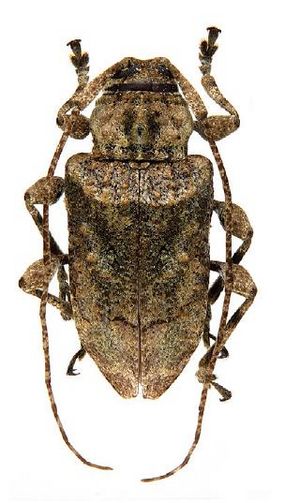Leptostylopsis humerofulvus facts for kids
Quick facts for kids Leptostylopsis humerofulvus |
|
|---|---|
 |
|
| Scientific classification | |
| Kingdom: | |
| Phylum: | |
| Class: | |
| Order: | |
| Family: | |
| Subfamily: |
Lamiinae
|
| Genus: |
Leptostylopsis
|
| Species: |
L. humerofulvus
|
| Binomial name | |
| Leptostylopsis humerofulvus Lingafelter & Micheli, 2009
|
|
Leptostylopsis humerofulvus is a type of longhorn beetle. These fascinating insects are known for their very long antennae, which can sometimes be longer than their bodies! This particular species belongs to a group of beetles called Lamiinae, which is a large subfamily within the longhorn beetle family. Scientists Lingafelter and Micheli officially described Leptostylopsis humerofulvus in 2009, giving it its scientific name.
Contents
What is a Longhorn Beetle?
Longhorn beetles are a big family of insects called Cerambycidae. They get their name from their antennae, which are often very long and curved, like the horns of a cow or goat. These antennae are not just for show; they help the beetle sense its surroundings, find food, and even locate mates. There are thousands of different longhorn beetle species found all over the world.
Appearance of Longhorn Beetles
Most longhorn beetles have a hard, protective outer shell. Their bodies are usually long and somewhat flat. The antennae are their most striking feature. They can be thin and whip-like, or thick and beaded. The colors of longhorn beetles vary a lot. Some are dull brown or black, helping them blend in with tree bark. Others are brightly colored with patterns, which might warn predators that they taste bad.
Where They Live
Longhorn beetles live in many different places around the world. You can find them in forests, woodlands, and even your backyard. They often prefer areas with lots of trees because their larvae (young beetles) usually live inside wood. Adult beetles might be seen on flowers, tree trunks, or flying around.
Life Cycle of a Longhorn Beetle
Like many insects, longhorn beetles go through a process called metamorphosis. This means they change completely during their lives.
Eggs and Larvae
A female longhorn beetle lays her eggs in cracks or holes in wood, often in dead or dying trees. When the eggs hatch, tiny larvae emerge. These larvae are sometimes called "roundheaded borers" because of their shape. They spend most of their lives tunneling through wood, eating it as they go. This stage can last for several months or even years, depending on the species and the conditions.
Pupae and Adults
Once a larva is fully grown, it forms a pupa inside the wood. This is a resting stage where the larva transforms into an adult beetle. After a period, the adult beetle emerges from the wood, often chewing its way out. Adult longhorn beetles usually live for only a few weeks or months. Their main job is to find a mate and lay eggs to start the next generation.
What Do They Eat?
The diet of longhorn beetles changes as they grow.
Larval Diet
Longhorn beetle larvae are mostly wood-eaters. They chew tunnels through the wood of trees, both living and dead. This helps break down dead wood in forests, which is an important part of the ecosystem. Some species prefer specific types of trees, like oak or pine.
Adult Diet
Adult longhorn beetles have a more varied diet. Many adults feed on nectar and pollen from flowers. This makes them important pollinators for some plants. Other adults might eat tree sap, decaying fruit, or even the bark of young twigs. Some species do not eat much at all as adults, focusing only on reproduction.
Importance of Longhorn Beetles
Longhorn beetles play several important roles in nature.
Decomposers
By tunneling through and eating dead wood, their larvae help break down fallen trees and branches. This process returns nutrients to the soil, which helps new plants grow. They are like nature's recycling crew.
Food Source
Longhorn beetles, both larvae and adults, are a food source for many other animals. Birds, small mammals, and other insects often prey on them. This makes them a part of the natural food web.
Indicators of Forest Health
The presence of certain longhorn beetle species can sometimes tell scientists about the health of a forest. A healthy variety of beetles often means a healthy forest ecosystem.
See also
 In Spanish: Leptostylopsis humerofulvus para niños
In Spanish: Leptostylopsis humerofulvus para niños

